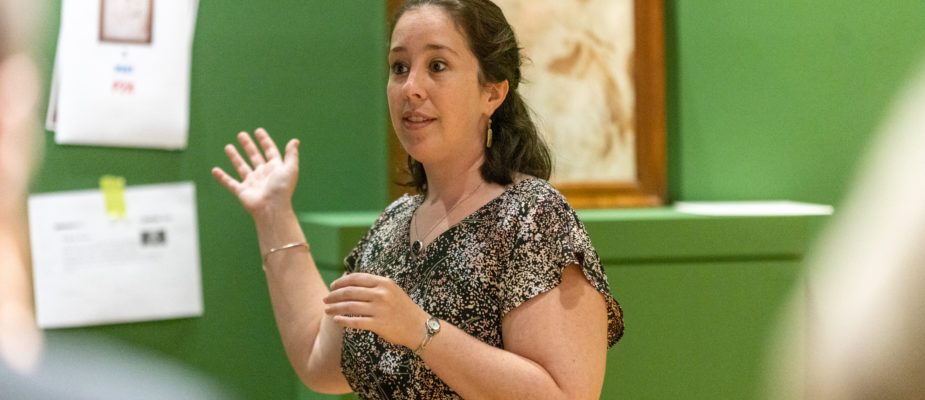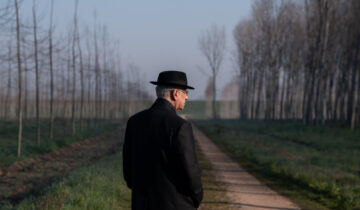Ask A Curator Day is an annual event for the curious public to ask questions about curators’ experience with their fascinating jobs, to create special engagement with curators around the globe. We at OKCMOA, asked our social media followers to present their most intriguing questions for the Museum’s curators to answer.
Bryn Schockmel, Ph.D., Curator and Catherine Shotick, Curator answer your questions!
Q: What makes OKCMOA special?
A: (Catherine Shotick) “OKCMOA is special because of the Museum’s important and unique collection of art (like the Chihuly glass collection) that allows us to fill the galleries with a variety of stories and experiences. Beyond our permanent collection, we also work with other institutions to bring in world-class traveling exhibitions, such as The Painters of Pompeii, for which we are the only North American venue. By visiting OKCMOA, you will have a truly unique experience, unlike any other museum.”
Q: Why did you become a curator?
A: (Bryn Shockmel) “I’ve always been passionate about art and art history and when I travel to new places (or return to old ones) my favorite thing to do is to visit museums. I enjoy seeing how museums organize their collections and exhibitions to tell different stories and, from the time I was in high school, being a curator seemed like a career path I would really love.”
Q: Has an exhibition inspired you to create, yourself?
A: (Bryn Shockmel) “I am definitely not an artist, but I do love learning about artistic processes. For example, with Pompeii, I’ve enjoyed learning more of the nitty-gritty details about how a fresco is made. For our upcoming exhibition on photographs by Walter Iooss Jr., it’s been really fascinating for me to learn more about the technical side of photography.
(Catherine Shotick) “I am drawn to textile arts and enjoy doing hand embroidery and quilting myself. OKCMOA hosted the Quilts and Color exhibition from the Museum of Fine Arts, Boston a few years ago that highlighted American quilts with bold colors and designs, and it spoke to me on a deep level. It was that exhibition that changed my personal textile arts style to create more ‘modern’ quilt and embroidery designs.”
Q: What has been the most challenging exhibition to curate?
A: (Bryn Shockmel) “Our spring 2022 exhibition, The Perfect Shot: Walter Iooss Jr. and the Art of Sports Photography, has been a fun challenge because I started with very little knowledge of sports. I’ve enjoyed learning about these amazing athletes and particularly how much professional sports have changed since Iooss began his career in the 1960s.”
Q: How do you come up with ideas for exhibitions?
A: (Catherine Shotick) “Sometimes an idea is sparked while I am reading an interesting article or book, or maybe while I am perusing the collection storage and see a work of art that hasn’t been on view in a while. A lot of the ideas may not come to fruition, but it is exciting when an idea does move forward.”
Q: Do you remember the first museum you visited?
A: (Bryn Shockmel) “I’m from upstate New York originally, so it was probably either the Albany Institute of History and Art or the New York State Museum, both of which have fantastic collections and which we visited often as a family.”
(Catherine Shotick) “The first museum I visited was the Lakeview Museum of Arts and Sciences in my hometown, Peoria, IL. It is now the Riverfront Museum and located in a new building, but my memories of the original galleries are crystal clear.”
Q: Did you study specifically to be a curator, or was it more of a career path that lines up with your personal/professional goals?
A: (Bryn Shockmel) “Yes, I knew I wanted to be a curator since I was about 14, so I studied art history in college and grad school, working towards that goal.”
(Catherine Shotick) “I always knew I wanted to do something with art and design, but it wasn’t until my first museum internship as an undergraduate that I knew I wanted to be a curator.”
Q: What has been the most challenging/rewarding thing about being a curator? any regrets as a curator?
A: (Catherine Shotick) “The most rewarding thing about being a curator is that the topic is constantly changing and I never feel bored at work. Most special exhibitions are on view for 3 months before it is time for the next one, and so I am constantly learning about art and artists. What could be better than that!?”








